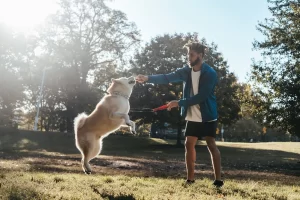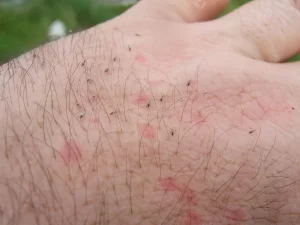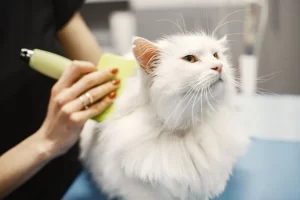If you are a dog owner, you know how important it is to keep your furry friend healthy and happy. Unfortunately, dogs can suffer from a variety of health problems, including prolapse. Prolapse is a condition in which an organ or tissue protrudes from its normal location, and it can be very uncomfortable and even painful for your pet. While veterinary care is essential for treating dog prolapse, there are some steps you can take at home to help promote healing and reduce discomfort. In this article, we will discuss how to heal dog prolapse at home and provide you with tips and advice to help your furry friend on the road to recovery.
Table of Contents
ToggleWhat is dog prolapse?
Dog prolapse occurs when an internal organ or tissue slips or protrudes outside of its normal position in the body. There are different types of prolapse that can occur in dogs, including rectal prolapse, vaginal prolapse, and uterine prolapse.
Rectal prolapse occurs when the rectum protrudes outside the anus. Vaginal prolapse occurs when the vaginal tissue protrudes outside of the vulva. Uterine prolapse occurs when the uterus slips into the vaginal canal and protrudes outside of the vulva.
The causes of prolapse in dogs can vary depending on the type of prolapse. Rectal prolapse can be caused by chronic diarrhea, constipation, straining to defecate, and other underlying medical conditions. Vaginal prolapse and uterine prolapse can be caused by hormonal imbalances, excessive straining during labor or delivery, and other underlying medical conditions.
Note that dog prolapse can be a serious medical condition that requires immediate attention from a veterinarian. If you suspect your dog is suffering from prolapse, it’s important to seek veterinary care as soon as possible to ensure the best possible outcome for your pet.
Signs and symptoms of dog prolapse
Identifying dog prolapse is crucial for ensuring prompt veterinary care for your pet. The symptoms of dog prolapse can vary depending on the type of prolapse, but may include:
- Rectal prolapse: This type of prolapse occurs when the rectum protrudes outside the anus. It appears as a pink or red mass, and your dog may exhibit signs of discomfort or pain. You may notice your dog attempting to lick or bite at the area, or having difficulty defecating. In severe cases, your dog may exhibit signs of rectal bleeding or have fecal matter leaking from the rectum.
- Vaginal prolapse: This type of prolapse occurs when the tissue of the vaginal wall protrudes outside of the vulva. It appears as a pink or red mass, and your dog may exhibit signs of discomfort or pain. You may notice your dog attempting to lick or bite at the area, or having difficulty urinating. Vaginal prolapse is more common in female dogs, particularly those who have recently given birth.
- Uterine prolapse: This type of prolapse occurs when the uterus protrudes outside of the vulva. It appears as a pink or red mass, and your dog may exhibit signs of discomfort or pain. Your dog may also be lethargic or show signs of weakness. Uterine prolapse is more common in female dogs, particularly those who have recently given birth.
Remember that the symptoms of dog prolapse can differ depending on the breed of the dog. For example, brachycephalic breeds such as Bulldogs and Pugs may be more prone to rectal prolapse due to their shortened snouts and breathing difficulties. Additionally, older dogs may be more prone to developing prolapse due to weakened muscles and tissues.
When to seek veterinary care
Dog prolapse is a serious medical condition that can lead to significant discomfort, pain, and even life-threatening complications if left untreated. It is important to seek veterinary care as soon as possible if you suspect your dog has prolapse. Delaying treatment may worsen the condition, making it more difficult to treat and increasing the risk of complications.
When you take your dog to the vet for prolapse, the veterinarian will perform a physical exam to assess the extent of the prolapse and identify any underlying medical conditions that may be contributing to the problem. In some cases, diagnostic tests such as X-rays, ultrasound, or blood tests may be necessary to fully evaluate the condition.
The treatment options for dog prolapse depend on the type and severity of the prolapse. In mild cases, your veterinarian may be able to manually push the prolapsed tissue back into place. This technique is called “reduction,” and it can be performed using gentle pressure and lubrication. However, in more severe cases, surgery may be necessary to correct the prolapse and prevent further complications.
Medical treatment options may include the use of medications to reduce inflammation and discomfort, or antibiotics to prevent infection. In cases of uterine prolapse, your veterinarian may administer hormones to help return the uterus to its proper position. In some cases, a combination of medical and surgical treatments may be necessary to fully treat the condition.
If left untreated, dog prolapse can lead to serious complications, such as infection, tissue damage, and even death. In some cases, the prolapsed tissue may become strangulated, leading to reduced blood flow and tissue death. The longer the condition goes untreated, the greater the risk of complications, and the more difficult it may be to treat.
In addition to seeking prompt veterinary care for your dog’s prolapse, it is important to follow your veterinarian’s instructions for post-treatment care. This may include administering medications, restricting activity, and monitoring your dog for signs of recurrence or complications. With proper care and treatment, most dogs with prolapse can make a full recovery and return to their normal activities. Check out here if you are not sure about how often you should take your dog to the vet.
Supplies and tools needed to treat dog prolapse at home
It is important to note that while home treatment may be effective in mild cases of dog prolapse, it is not a substitute for veterinary care. Before attempting to treat your dog’s prolapse at home, you should seek the advice of a veterinarian to determine the best course of treatment.
If your veterinarian determines that it is safe to treat your dog’s prolapse at home, they may provide you with specific instructions and guidelines for the treatment. Here are some of the supplies and tools that may be needed for home treatment of dog prolapse:
- Lubrication: A water-based lubricant such as KY jelly or petroleum jelly can be used to help reduce discomfort and facilitate the manual reduction of the prolapse.
- Clean towels or cloths: Clean towels or cloths can be used to gently clean the affected area before treatment and to protect the area from further contamination or injury.
- Sterile gloves: Wearing sterile gloves can help prevent infection and protect your hands during the treatment.
- Epsom salts: Epsom salts can be used to create a warm compress that can help reduce swelling and discomfort.
- Sterile saline solution: A sterile saline solution can be used to clean the affected area and prevent infection.
- Over-the-counter pain medication: Over-the-counter pain medication such as acetaminophen or ibuprofen may be used to reduce pain and inflammation.
It is worth noting that home treatment options such as manual reduction should only be attempted under the guidance of a veterinarian, as improper technique or use of non-sterile tools may cause further harm.

Cleaning the affected area to avoid infection
Proper cleaning of the affected area is an important part of treating dog prolapse at home. Improper cleaning can lead to further irritation, infection, and delayed healing. The specific cleaning instructions will depend on the type of prolapse your dog is experiencing. Here are some general guidelines:
- Anal prolapse: If your dog has an anal prolapse, it is important to keep the area clean and dry. Use clean, warm water and a mild soap to gently clean the area around the prolapse. Avoid using harsh soaps, disinfectants, or other irritants. After cleaning, gently pat the area dry with a clean towel or cloth.
- Vaginal prolapse: If your dog has a vaginal prolapse, it is important to keep the area clean and dry to prevent infection. Use a sterile saline solution to clean the area around the prolapse. You may also use a water-based lubricant such as KY jelly or petroleum jelly to help reduce discomfort and facilitate the manual reduction of the prolapse. After cleaning, gently pat the area dry with a clean towel or cloth.
- Uterine prolapse: If your dog has uterine prolapse, it is important to keep the area clean and dry to prevent infection. Use a sterile saline solution to clean the area around the prolapse. Your veterinarian may also prescribe antibiotics to prevent infection. After cleaning, gently pat the area dry with a clean towel or cloth.
- Rectal prolapse: If your dog has a rectal prolapse, it is important to keep the area clean and dry to prevent infection. Use clean, warm water and a mild soap to gently clean the area around the prolapse. Avoid using harsh soaps, disinfectants, or other irritants. After cleaning, gently pat the area dry with a clean towel or cloth.
It is important to note that in some cases, manual reduction of the prolapse may be necessary. Before attempting to manually reduce the prolapse, it is important to seek veterinary guidance and ensure that you have the proper tools and techniques to do so safely and effectively.
A cold compress can reduce swelling and discomfort in dogs with prolapse
Applying a cold compress can help reduce swelling and discomfort in dogs with prolapse. However, the specific method of applying a cold compress will depend on the type of prolapse your dog is experiencing. Here is the general guideline:
To apply a cold compress to a dog with prolapse, wrap a cold pack or ice pack in a clean towel or cloth. Apply the compress to the area around the prolapse for 10-15 minutes at a time, several times a day. Do not apply the cold pack directly to the skin, as this can cause frostbite.
It is important to note that while a cold compress can help reduce swelling and discomfort, it is not a substitute for veterinary care. If your dog has a prolapse, it is important to seek veterinary attention as soon as possible to determine the underlying cause and develop an appropriate treatment plan.
Medications, over-the-counter medicines, and products for dogs with prolapse
Administering medication can be an important part of treating dog prolapse, but it is important to only use medication as directed by a veterinarian. Here are some types of medication that may be used to treat dog prolapse:
- Anti-inflammatory drugs: These medications, such as ibuprofen or aspirin, can help reduce swelling and inflammation in dogs with prolapse. However, these medications should only be used under the guidance of a veterinarian, as they can have side effects and may not be appropriate for all dogs.
- Antibiotics: If the prolapse is due to an infection or if the area has become infected, antibiotics may be prescribed to help clear up the infection and prevent further complications.
- Laxatives or stool softeners: In cases of rectal prolapse, a veterinarian may prescribe a laxative or stool softener to help make bowel movements easier and reduce the risk of further prolapse.
- Hormonal therapy: In cases of vaginal prolapse or uterine prolapse, hormonal therapy may be used to help support the pelvic tissues and prevent further prolapse.
It is important to note that medication should only be administered as directed by a veterinarian, and pet owners should never give their dogs medication without first consulting a professional.
If medication is prescribed, it is important to follow the veterinarian’s instructions for administration closely. This may include giving the medication with food or at specific times of day or administering medication in a specific way (such as using a pill pocket or hiding medication in food). Additionally, it is important to monitor your dog closely for any side effects or adverse reactions to the medication and to contact your veterinarian immediately if you notice any concerning symptoms.
Manage pain and discomfort in dogs suffering from prolapse
Managing pain and discomfort is an important aspect of treating dog prolapse. Here are some tips for providing pain relief:
- Prescription pain medication: Your veterinarian may prescribe medication to help manage your dog’s pain. These medications can range from non-steroidal anti-inflammatory drugs (NSAIDs) to opioids, and should only be used as directed by your veterinarian.
- Environmental modifications: Making modifications to your dog’s environment can also help provide pain relief. This may include providing a soft, supportive surface to rest on, or elevating food and water dishes to reduce strain on the neck and back.
- Natural pain relief: There are some natural remedies that may help provide pain relief for dogs with prolapse. These can include:
- Cold therapy: Applying a cold compress to the affected area can help reduce pain and inflammation. Use a towel or cloth soaked in cold water and apply it to the affected area for 10-15 minutes at a time.
- Warm therapy: Applying a warm compress to the affected area can also help reduce pain and inflammation. Use a towel or cloth soaked in warm water and apply it to the affected area for 10-15 minutes at a time.
- Massage: Gentle massage can help stimulate blood flow and reduce muscle tension, which can help alleviate pain and discomfort.
- Acupuncture: Acupuncture is a holistic therapy that can help alleviate pain and promote healing. It involves the insertion of thin needles into specific points on the body.
Providing proper nutrition, diets, and supplements
When it comes to treating dog prolapse, providing proper nutrition, diets, and supplements can play a crucial role in supporting your dog’s recovery. Here are some tips for providing the right nutrition to your dog:
- High-quality diet: A high-quality diet that is rich in nutrients, protein, and fiber is essential for dogs with prolapse. Look for diets that are formulated specifically for dogs with digestive or immune system issues. These diets should contain ingredients that are easily digestible and nutrient-dense, such as lean proteins, whole grains, and vegetables. Some examples of high-quality diets include prescription diets or diets formulated for dogs with sensitive stomachs.
- Proper feeding: Proper feeding is also crucial for dogs with prolapse. Feed your dog small, frequent meals throughout the day instead of large, infrequent meals. This can help reduce strain on the digestive system and prevent further complications. Choose high-quality, easily digestible foods and avoid giving your dog table scraps or other foods that could exacerbate their symptoms.
- Supplements: Supplements can help support your dog’s recovery from prolapse. Some supplements that may be beneficial include:
- Probiotics: Probiotics are beneficial bacteria that can help support your dog’s digestive system and immune system. They can also help reduce inflammation and improve nutrient absorption. Look for a high-quality probiotic supplement that contains multiple strains of bacteria.
- Omega-3 fatty acids: Omega-3 fatty acids are anti-inflammatory and can help reduce inflammation and promote healing. They can also support a healthy immune system. Look for a high-quality fish oil supplement that is specifically formulated for dogs.
- Glucosamine and chondroitin: Glucosamine and chondroitin are supplements that can help support joint health and mobility, which can be beneficial for dogs with prolapse.
Importance of rest and recovery for dogs with prolapse
Rest and recovery are crucial for dogs with prolapse. Here are some tips on how to properly care for your dog during this time:
- Limit activity: Dogs with prolapse should be confined to a small, quiet space where they can rest and recover. Limit their activity as much as possible to prevent further injury or complications. Avoid taking them on walks or engaging in any strenuous activities.
- Comfort: Provide your dog with a comfortable bed or resting area. Use soft bedding and provide extra padding to relieve pressure on the affected area. You may also want to consider providing your dog with a supportive, orthopedic bed or cushion to help alleviate discomfort.
- Medications: Work with your veterinarian to determine if any pain medications or anti-inflammatory medications are necessary to help manage your dog’s pain and promote healing.
- Bathroom breaks: Make sure to provide your dog with frequent bathroom breaks to prevent further strain on the affected area. If your dog is having difficulty moving or using the bathroom, your veterinarian may recommend additional support, such as a sling or harness, to help your dog move more comfortably.
- Emotional support: Dogs with prolapse may be feeling anxious or stressed due to their condition. Provide your dog with plenty of emotional support and reassurance during this time. Spend time with them, provide plenty of attention, and offer treats or toys to help keep them distracted and comfortable.

How to prevent prolapse from recurring in dogs
Preventing prolapse from recurring in dogs involves several steps, including:
- Proper diet: A balanced diet that meets your dog’s nutritional needs is essential for maintaining good overall health and preventing conditions that can lead to prolapse. Work with your veterinarian to develop a diet plan that is appropriate for your dog’s specific needs.
- Regular exercise: Regular exercise can help keep your dog’s muscles strong and prevent weakness or injury that can lead to prolapse. However, be sure to avoid overexertion or strenuous activity that could cause harm.
- Proper hygiene: Proper hygiene is crucial in preventing infections that can lead to prolapse. Make sure to keep your dog’s genital area clean and dry, and consider using a gentle, pet-safe wash to keep the area clean.
- Regular veterinary check-ups: Regular check-ups with your veterinarian can help identify any potential health issues early on, including those that could lead to prolapse. Your veterinarian can also provide advice on how to prevent certain health issues and maintain your dog’s overall health.
- Avoiding trauma: Avoiding trauma to the genital area can help prevent prolapse. This can involve avoiding rough play, using caution during breeding, and providing appropriate support during pregnancy and whelping.
When surgery may be necessary to treat dog prolapse
Surgery may be necessary to treat dog prolapse if the prolapse is severe or if other treatment options have been unsuccessful. The specific type of surgery needed will depend on the type of prolapse and the severity of the condition.
For example, surgery for rectal prolapse may involve the removal of the prolapsed tissue and reattachment of the remaining tissue to the rectal wall. In cases of vaginal or uterine prolapse, surgery may involve the removal of the affected organ, such as a spay surgery to remove the uterus.
Before surgery, your veterinarian will perform a thorough examination and may recommend bloodwork or other tests to assess your dog’s overall health. During the procedure, your dog will be under general anesthesia to ensure they are comfortable and do not experience pain.
After surgery, your dog will need time to recover and may require pain medication and/or antibiotics to prevent infection. Your veterinarian will provide instructions on how to care for your dog during the recovery period and may recommend limiting activity or providing a special diet.
The cost of surgery for dog prolapse can vary depending on the type of surgery needed, the severity of the condition, and other factors such as geographic location and the experience of the veterinary surgeon. In general, surgical treatment for prolapse can cost several hundred to several thousand dollars. It is important to discuss the potential cost of treatment with your veterinarian to ensure you are prepared for any financial obligations associated with surgery.
Post-surgical care of a dog with prolapse
After surgery for dog prolapse, it is important to follow your veterinarian’s instructions carefully to ensure a successful recovery. Here are some tips to help care for your dog after surgery:
- Limit activity: Your dog will need to rest and limit activity for a period of time after surgery. This may involve restricting access to stairs, jumping, or other activities that could put strain on the surgical site.
- Monitor incision site: Keep an eye on the surgical site for signs of infection, such as redness, swelling, or discharge. Your veterinarian may provide instructions on how to clean and care for the incision site.
- Administer medications: Your veterinarian may prescribe pain medication, antibiotics, or other medications to help manage pain and prevent infection. It is important to administer these medications exactly as directed.
- Provide a comfortable recovery space: Make sure your dog has a comfortable space to rest and recover after surgery. This may involve providing a soft bed or blanket, as well as access to food and water.
- Follow-up appointments: Your veterinarian will likely schedule follow-up appointments to monitor your dog’s recovery and remove any stitches or staples that were used during the surgery.
Potential complications of dog prolapse
If left untreated, dog prolapse can lead to serious complications that can affect your dog’s health and well-being. Some potential complications of dog prolapse include:
- Infection: The exposed tissue can become infected, leading to pain, inflammation, and even sepsis if left untreated.
- Strangulation: If the tissue becomes trapped outside the body for an extended period of time, it can lose blood flow and become necrotic, leading to tissue death.
- Recurrence: Without proper treatment and follow-up care, dog prolapse can recur, leading to additional discomfort and complications.
- Organ damage: In some cases, prolapse can lead to damage to the internal organs, particularly if the prolapse affects the urinary or reproductive systems. If your dog is suffering from a urinary tract infection (UTI), you may want to look into these home treatments as well.














